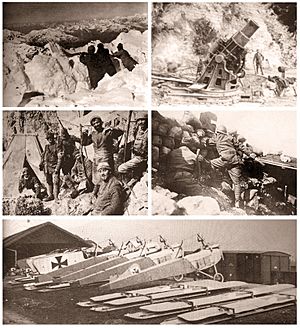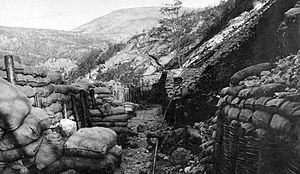Italian Campaign (World War I) facts for kids
Quick facts for kids Italian Front |
|||||||
|---|---|---|---|---|---|---|---|
| Part of World War I | |||||||
 From left to right: Ortles, autumn 1917; Fort Verena, June 1915; Mount Paterno, 1915; Carso, 1917; Toblach, 1915. |
|||||||
|
|||||||
The Italian Front was a major battle area during World War I. It was also called the "Mountain War." This front was located along the border between Austria-Hungary and Italy. Battles took place there from 1915 to 1918.
Italy joined the war because of secret agreements with the Allies. These agreements, made in the Treaty of London, promised Italy new lands. Italy wanted to gain control of areas like the Austrian Littoral, northern Dalmatia, and parts of what are now Trentino and South Tyrol.
Italy hoped to win these lands quickly with a surprise attack. However, the fighting soon turned into trench warfare. This was similar to the Western Front in France. But on the Italian Front, battles happened at very high altitudes. Soldiers also faced extremely cold winters.
The fighting forced many civilians to leave their homes. Thousands of people died from hunger and sickness. This happened in both Italian and Austrian refugee camps. The war on this front ended with the Allied victory at Vittorio Veneto. The Austro-Hungarian Empire also began to fall apart.
Contents
Fighting in the Mountains: Tunnel Warfare

From 1915, the tall peaks of the Dolomites mountains saw very intense fighting. This was known as mountain warfare. To keep soldiers safe from enemy fire and the harsh mountain weather, both sides built tunnels. These "fighting tunnels" offered protection and helped move supplies.
Building these tunnels was very difficult. Engineers and miners from both Austria-Hungary and Italy worked at high altitudes. They dug through hard rock and even glacial ice. This work required great skill and bravery.
A terrible event happened on December 13, 1916. This day became known as White Friday. About 10,000 soldiers on both sides died from huge avalanches in the Dolomites.
Besides building underground shelters and covered supply routes, like Italy's Strada delle 52 Gallerie, both armies tried something else. They dug tunnels under the "no man's land" between their trenches. They then placed explosives under the enemy's positions. This was an attempt to break the deadlock of trench warfare. Between January 1, 1916, and March 13, 1918, 34 mines were exploded in this way.
How the War Ended on the Italian Front
By October 1918, Italy had enough soldiers to launch a major attack. This attack was aimed at Vittorio Veneto, across the Piave River. The Italian Army broke through the enemy lines near Sacile. They sent in many more soldiers, which crushed the Austrian defenses. On November 3, 300,000 Austrian soldiers surrendered.
On November 3, the military leaders of Austria-Hungary asked for a truce. They sent a flag of truce to the Italian commander. The terms of peace were agreed upon with the Allied leaders in Paris. The Armistice with Austria was signed at Villa Giusti, near Padua. It took effect at 3:00 PM on November 4. Austria and Hungary later signed separate armistices. This happened after the Habsburg Monarchy fell apart.
The battles along the Soča (Isonzo) River caused huge losses. Half of all Italian war deaths, about 300,000 out of 600,000, happened there. Austro-Hungarian losses were also very high. Around 400,000 soldiers died out of their total of 1.2 million casualties.
Images for kids
-
A pro-war demonstration in Bologna, 1914.
-
The Italian front in 1918 and the Battle of Vittorio Veneto.
-
Italian troops landing in Trieste, 3 November 1918
See also
 In Spanish: Frente italiano (Primera Guerra Mundial) para niños
In Spanish: Frente italiano (Primera Guerra Mundial) para niños












